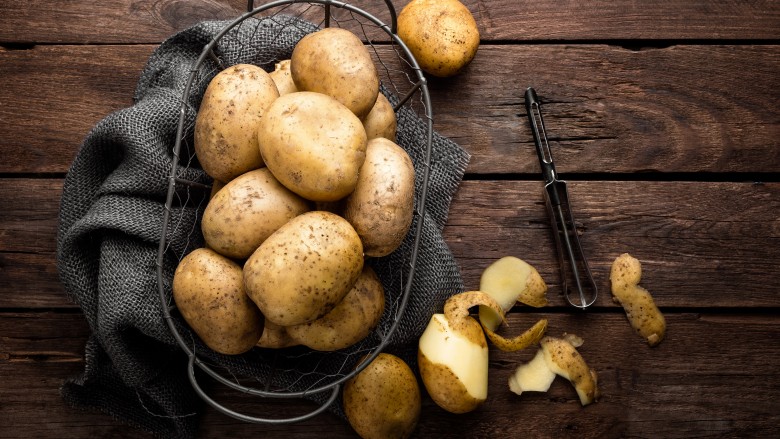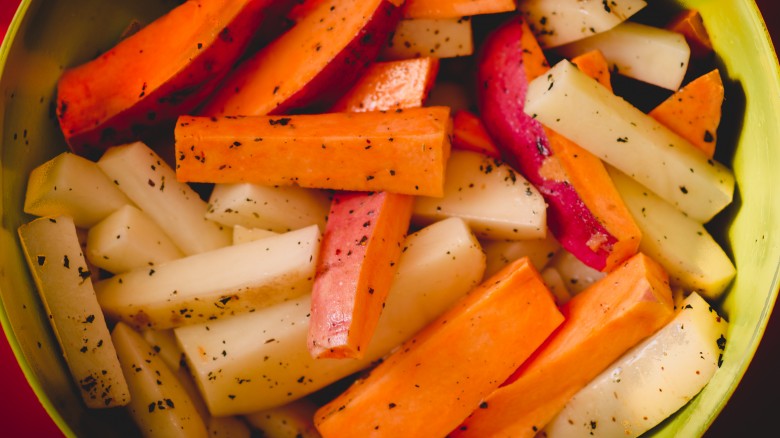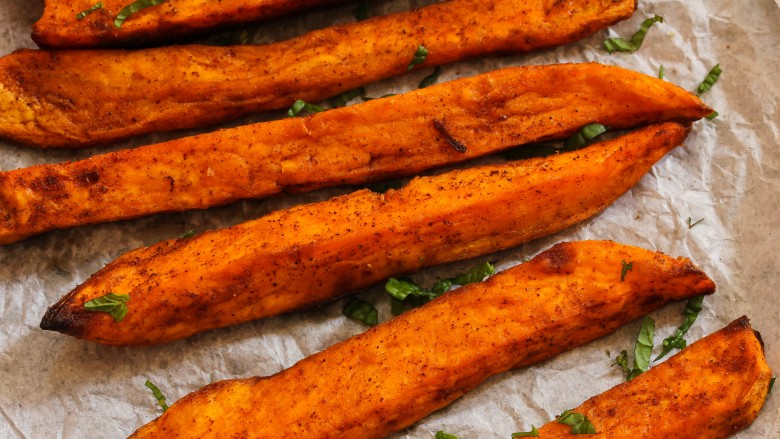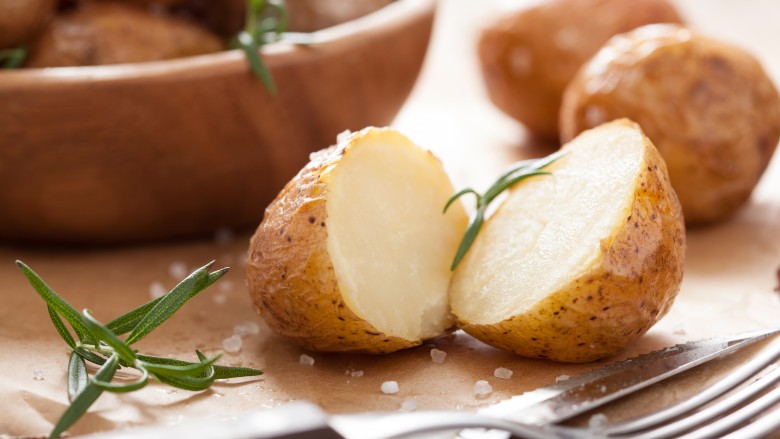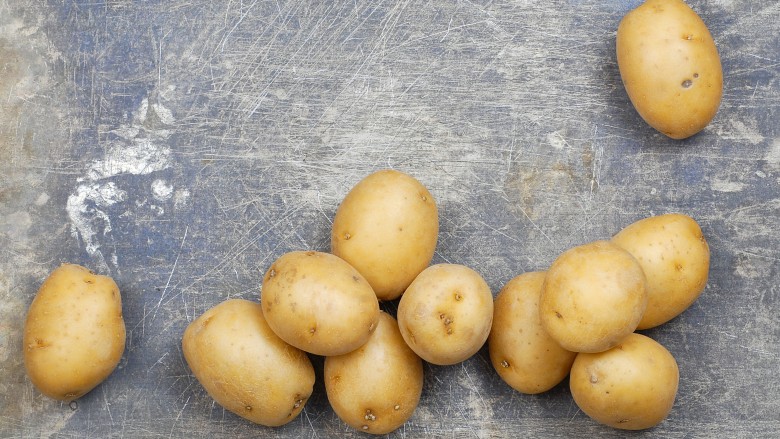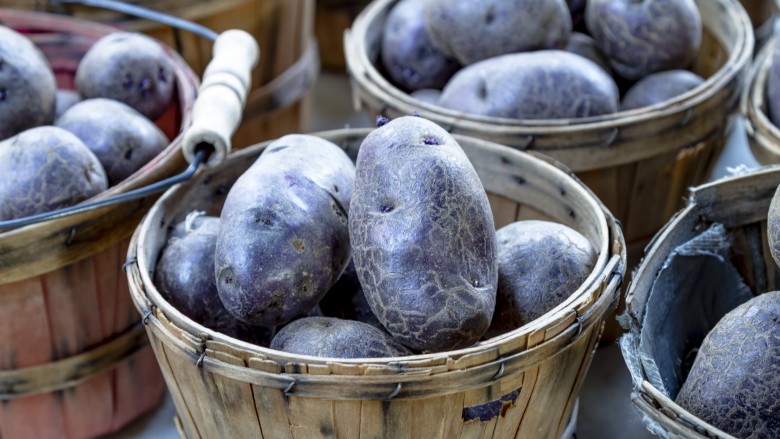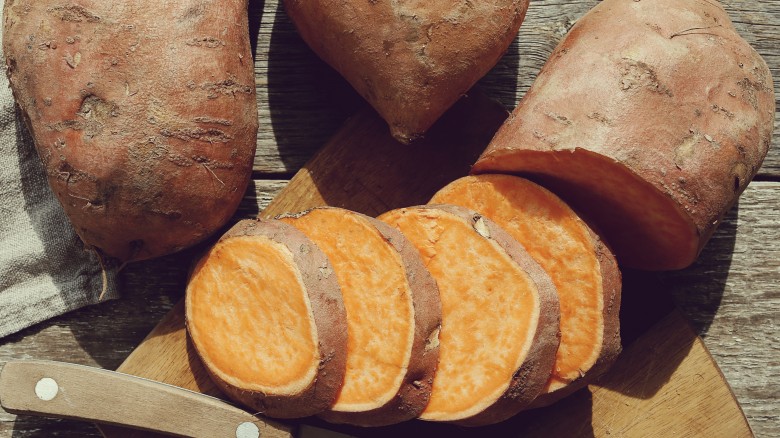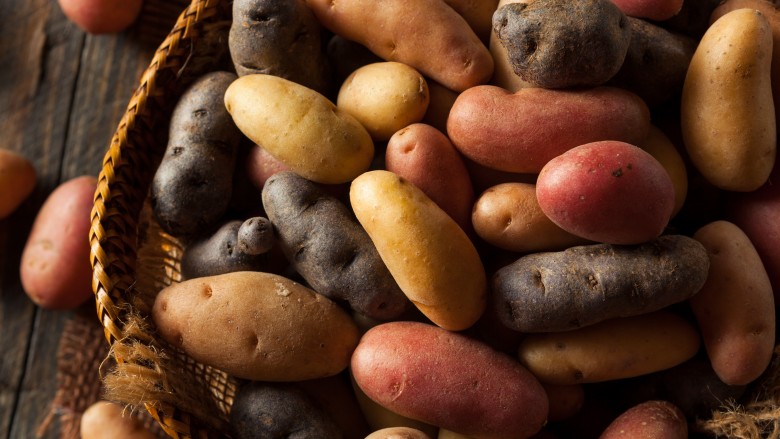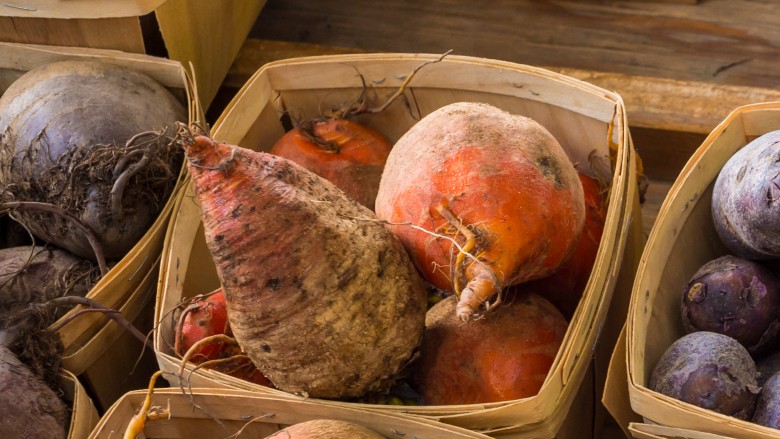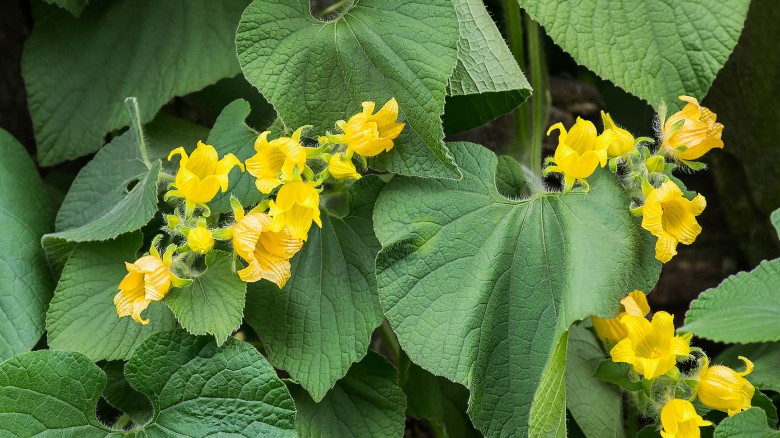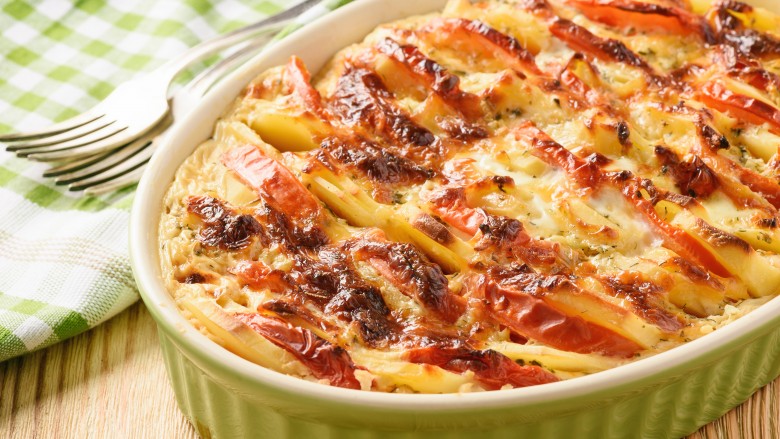The Difference Between Every Kind Of Potato
The world loves its potatoes, and you probably do, too. They're the perfect side dish, whether you're roasting them, boiling them, turning them into fries or something more exotic, like latkes. Every meal of the day can include potatoes, from morning hash browns to late-night, post-pub fish 'n' chips. Head to the grocery store or the farmer's market, and you'll be confronted with a pretty baffling array of potatoes. Some are white, some are purple, and others are long and skinny. You have a sneaking suspicion that some might not even be potatoes at all. You may be surprised to find out, however, that they're not all interchangeable in how you use them. The wrong kind of potato can take a dish from stellar to sad in an instant. We're going to take a look at the different qualities that the most popular types of potatoes have, which ones you should be buying for which purposes, and what separates one kind from the next.
What's the difference between grades of potatoes?
If you've picked up potatoes at the grocery store, you've probably seen them labeled with some official-looking designations. Different grades and standards are used to define potato quality, but most people probably don't know what the actual differences between them are.
The three main grades are U.S. No. 1, U.S. No. 2, and U.S. Commercial. In order to meet the lowest bar, U.S. No. 2, potatoes must be of a certain size (more than 1.5 inches in diameter, unless they're a variety that's consistently smaller), not misshapen, showing all the standard characteristics of the variety, and free from obvious damage done by things like freezing and rot. The guidelines for being assigned a U.S. No. 1 designation are unsurprisingly a little more strict, and these potatoes are required to be no smaller than 1⅞ inches in diameter, firm, clean, well-shaped, and meet all the requirements for a U.S. No. 2 designation.
For U.S. Commercial, the requirements are a little odd. Here, they have to meet all the same requirements as potatoes given the U.S. No. 1 grade, but they can have a little more visible damage like russet scab (a disease that leaves scab-like tissues on the potato's surface) and rhizoctonia (a fungal infection that causes root and stem rot). These potatoes aren't held to the same visual standards that other grades are, so they can look a little funky.
Physical differences between potatoes and sweet potatoes
The debate over whether potatoes or sweet potatoes are healthier is surprisingly complicated, so let's start with the physical differences.
Sweet potatoes and potatoes both came from South America, but they're actually in different families. Of the two, sweet potatoes are a lot more delicate. They can't tolerate the cold and the frost like potatoes can, and they're a lot more sensitive to the presence — or absence — of daylight. You can't necessarily tell which is a sweet potato just with a quick glance, either, as they're not all the distinctive orange color we usually think of, and some are even white.
Nutritional differences between potatoes and sweet potatoes
Now, the nutritional differences, and this is where things get a little hazy. There are a couple different ways the nutritional value of potatoes can be measured: in grams or in whole potatoes. When potatoes and sweet potatoes were compared in grams, there wasn't much difference in most areas. When you took a medium-sized potato and compared that to a medium-sized sweet potato, though, the differences showed up. That's the method the USDA uses. This time, the sweet potato has fewer calories, fewer carbs, and less protein. Sweet potatoes have more sugars, though, and more than four times your daily recommended amount of vitamin A.
Sweet potatoes are higher in fiber, magnesium, and vitamin C, but lower in potassium. Of course, when you put either one into fried form, you'll get almost equal amounts of fat — and no one wants that.
What does it mean when potatoes are called waxy or starchy?
You might hear different types of potatoes described as either waxy or starchy, and it's sort of an odd thing to hear. The difference is basically in the texture, and that, in turn, impacts which is the best way to use each type. At the most basic levels, there are two different things that determine the quality of a potato: the amount of starch it contains, and the amount of water. The higher the starch content, the more floury it'll be. The higher the water content, the more waxy the texture will be.
That's important. Waxy potatoes aren't good at absorbing things like oil and dressing, and when you cook them, they're going to hold together better than a starchy potato will. Those starchy potatoes, on the other hand, absorb flavors and break up easily once they're cooked. That makes them great for things like mashed potatoes, because it's that starch content that's going to keep your mashed potatoes from turning to a gluey paste.
There are dozens of potato varieties, but as long as you're familiar with the idea of starches and what it means for your final product, you'll know which ones to use just based on their starchy or waxy nature. It's tough to label particular varieties either starchy or waxy, though, as some potatoes change their texture throughout the growing season. That's why the all-purpose potato can be your best friend.
What makes all-purpose potatoes different?
All-purpose potatoes aren't overly starchy or overly waxy, and their middle-of-the-road characteristics make them popular choices. Even if you can only name a couple types of potato varieties, they're probably all-purpose varieties. That includes the Yukon Gold, a variety that's in stores all over and renowned for being a good choice whether you're boiling, baking, or slicing them into fries.
All-purpose potatoes are also called medium-starch potatoes. They'll stay together if you boil them, and they're also good for mashing and deep frying, but they won't have quite the same fluffy texture as a high-starch potato. For most things, though, they're perfectly fine, and there's the added bonus of needing to pick up and store only one kind of potato no matter what meals you have planned for the week.
What makes purple potatoes different?
You've probably heard people sing the praises of the sweet potato when it comes to finding another option for dinner, and you might have more recently heard people start talking about the purple potato. If you're wondering what makes these so special, you're certainly not alone.
Like other potatoes, purple ones also come from South America, and there are a lot of different varieties. You might have seen potatoes like the purple Peruvian taking up space in the grocery store, alongside names like purple majesty and purple Viking. They have similar benefits, though, and purple potatoes are similar to more familiar white potatoes in nutrition, save for a few important factors. They're incredibly high in antioxidants, containing about four times as many as your typical white potato.
Studies have suggested that they're also good for lowering blood pressure. A University of Scranton study tracked the blood pressure and weight of participants who were given 6-8 potatoes (most purple potatoes are about the size of a golf ball) every day, and a control group that ate normally. Those who added purple potatoes to their diet saw their drop slightly. That, along with the antioxidants of the purple potato, means that this particular type packs an extra nutritional punch. Of course, you'd have to eat a lot of purple potatoes to get these results.
What's the difference between yams and sweet potatoes?
You've probably heard someone use "yam" and "sweet potato" interchangeably, and you might have even done it yourself. But the two are actually very different and aren't in the same botanical family. (Technically, neither are even in the potato family, even though we usually call them potatoes.) The sweet potato is actually a part of the morning glory family. Yams are more closely related to grasses and palms. The U.S. and North Carolina lead the way in the production of sweet potatoes, and yams hailing from Central America, Southeast Asia, and the Caribbean. Originally, they're from Africa. Even today, they aren't grown in the U.S., so the only true yams you'll find are imported.
They look completely different, too. Those root vegetables you're more familiar with — the tapered, smooth things that do look a bit like a potato's cousin — are sweet potatoes. Real yams are shaped like a cylinder, lack the tapered ends of a sweet potato, and have skin that's rough and feels almost hairy.
Because the FDA doesn't actually regulate the names of the two foods, you'll see them labeled interchangeably even in the grocery store. Historians think the misidentification started when sweet potatoes first became a staple crop in the South. At the time, they were grown by a population of slaves, who used the word "yam" to describe them. It comes from the African word "nyami," meaning "to eat."
What's the difference between new potatoes and fingerling potatoes?
Yams and sweet potatoes aren't the only types of root vegetable that get easily confused, and if you've ever looked at new potatoes and fingerlings side by side, you know how baffling it can be. The difference, once you're familiar with it, is simple. Fingerlings are an actual variety of potatoes. They're long and slender, and they get their name from their shape and their size. They're about the size of a finger, but they're fully grown. They taste like their larger counterparts, and even though their skin is more delicate than larger white potatoes, they're more flexible for different dishes and preparations.
New potatoes, on the other hand, are literally baby potatoes of any variety harvested before the crop is entirely mature. Pulling out some of these little potatoes thins a crop, makes room in the soil, and allows the remaining potatoes to reach their full size. Their skin is generally very delicate because they weren't allowed to fully mature before they were harvested. Some new potatoes usually have a shape similar to fingerlings, but that's because they aren't full-grown. Others look more like tiny versions of regular potatoes, and they all have a creamy texture and a sweeter flavor than if they were fully matured. Once you bring them home, they don't last as long as a full-grown potato, so hurry up with using these!
What makes an heirloom potato?
You might have heard the term "heirloom" potato tossed around, especially if you make it a point to visit your local farmer's market on a regular basis. Heirloom potatoes — and other vegetables — are separated from their non-heirloom counterparts by a couple of different things. As a general rule, heirloom crops are grown on a small scale and have remained the same for at least 50 years. Most potatoes produced on a commercial scale are hybrids that have been cultivated over the years to produce the best-looking, largest, and most cost-effective products, while heirlooms are pollinated and bred more naturally. They tend to look a little odd and taste a little different. Recently, they've been in high demand.
In 2013, Irish farmers resurrected an heirloom potato that had once been the backbone of the nation's diet. The Lumper potato was a major staple until the famine started in 1845, wiping out most of the potato crop and a huge part of the country's population. After the blight, the Lumper all but disappeared until a potato farmer from Northern Ireland decided to give the potato another chance. Michael McKillop got a handful of seeds and started planting. According to those who have tried it, the taste of this particular potato ranges from "soapy" to "not bad" to "edible," suggesting that not all heirloom crops carry the same desirability factor you might expect.
What makes wild potatoes 'wild'?
If you were to name all the different types of potatoes you could think of, you could probably come up with a handful of names and varieties. There are dozens of different species of wild potato, and there are between 100-180 different kinds, according to the International Potato Center. They're spread across the southwestern U.S. and into the southernmost reaches of Chile. Surprisingly, they're largely inedible.
So what happened along the way, and how did they go from inedible to the fourth-largest food crop in today's world?
This question isn't easily answered. It's thought that potatoes were originally domesticated in South America — they were worshiped by the Inca — and spread not from a single species or location but from several. Outside South America, they spread first to the Canary Islands in the 16th century. Generations of cultivation have created the food source we know and love today, and farmers may be going back to the wild cousins of the potato to introduce a new quality. In 2016, researchers found a variety of wild potato that contained nearly seven times the amount of calcium of any domesticated potato. If you've ever cut open a potato and found dark spots inside, that's a calcium deficiency. Interbreeding our staple crops with wild potatoes can help increase desirable traits and diversify the species, hopefully preventing things like the Irish potato famine from happening again.
So, which potatoes should you choose?
Now that you know a little more about the different types of potatoes, what are the guidelines when it comes to picking the right ones for the job?
You want to consider what form you want your potatoes to take when they make it to your plate (or bowl). If you want them to end up looking the same way after cooking as they did before cooking, you'll want something low in starch. Red potatoes and fingerlings are great for things like soups, potato salads, and stews. If you're going to be changing the shape and state of the potato before you serve it, you'll want those high-starch varieties that absorb flavors and end up mashed or fried: think Russets.
If you aren't sure what kind of starch content a particular potato has, there's one simple trick that can help you tell the difference. Look at the skin. If it feels thin, it'll be a waxy potato that will hold its shape when you cook it. If it's a thicker skin, it'll be better as a mashed potato. It's a simple guideline that can help point you in the right direction when it comes to picking the best potato for the job. Hopefully, it'll help you get more confident when it comes to picking up something new at the farmer's market or whole foods store. Who doesn't want to try something new? Especially when you have some inside information on what it's going to look like on the plate!

